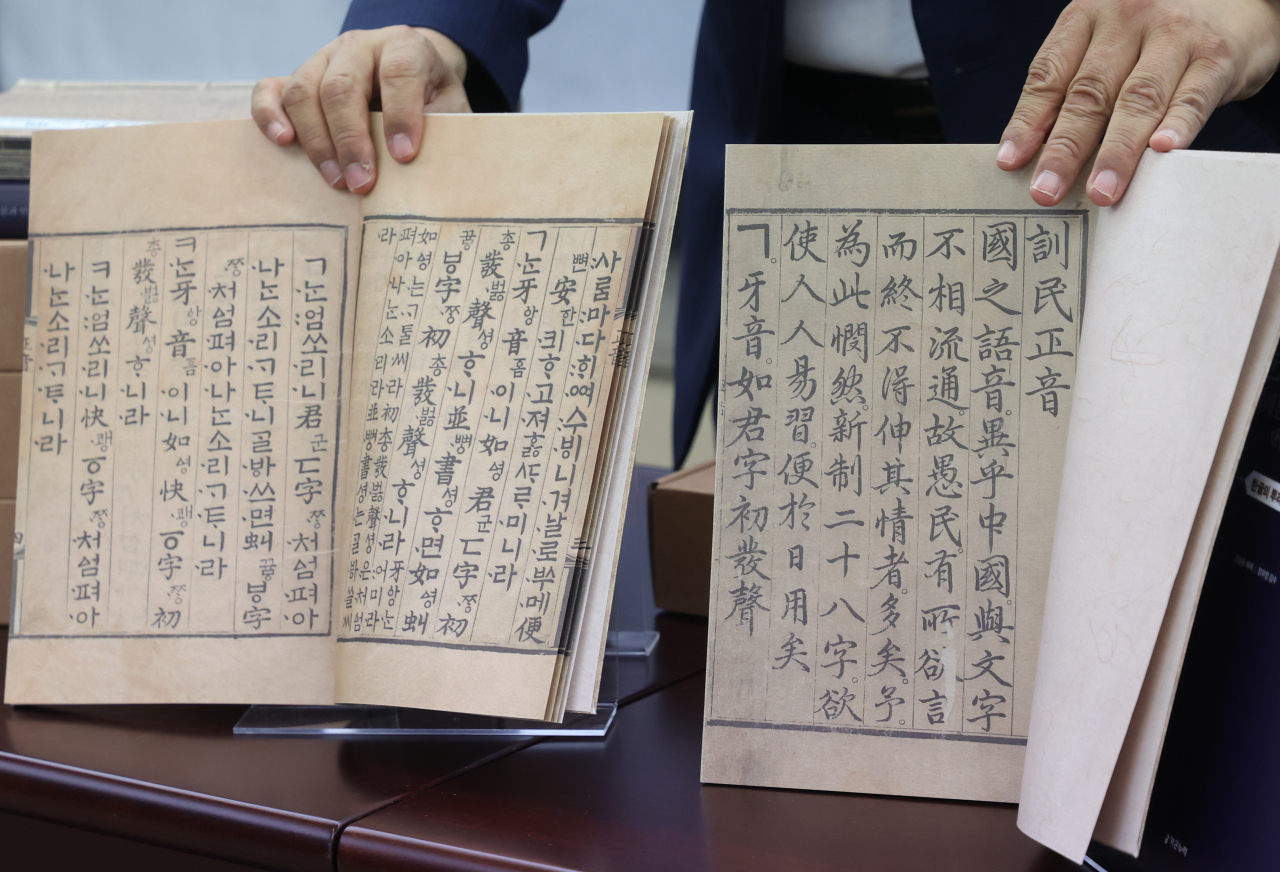Seminal texts on Hangeul reproduced right down to hanji pages
'Hunminjeongeum Haerye' and 'Hunminjeongeum Eonhae' reprinted on traditional mulberry paper ahead of Hangeul Day
By Hwang Dong-heePublished : Oct. 5, 2023 - 19:19

When King Sejong the Great promulgated Hangeul in 1446 -- after creating the writing system in 1443 -- the announcement was accompanied by the publication of "Hunminjeongeum Haerye," a book written by the king and eight scholars involved in the creation of Hangeul that explains the creation of Hangeul and the principles behind its letters and the writing system.
The book was written in Hanja, or Chinese characters.
Later, during King Sejo's reign, "Hunminjeongeum Haerye" was published in Hangeul as "Hunminjeongeum Eonhae" for easier comprehension.
"Haerye" and "Eonhae" have now been reprinted and published as a pair -- "Eonhae" for the first time.
The reprints were unveiled by Gaonnuri Publisher during a press conference in Jung-gu, Seoul, on Thursday, four days ahead of Hangeul Day on Oct. 9. This year marks the 580th anniversary of the creation of Hangeul and the 577th anniversary of the distribution of "Haerye."
"Hunminjeongeum Haerye" is National Treasure No. 70 and has been included in the UNESCO Memory of the World Register since October 1997. The original publication consists of 65 pages.
During the Japanese colonial period, most of the references related to "Hunminjeongeum" were damaged. As a result, the only existing "Haerye" passed down to this day is the one owned by the Kansong Art and Culture Foundation, which initiated the reprinting project.
For nearly 500 years, the whereabouts of "Haerye" had remained unknown. In 1940, Jeon Hyeong-pil, a wealthy collector also known as Gansong, acquired it for a sum equivalent to the price of dozens of houses at the time. Since then, it has been made accessible to the public only a few times due to conservation and security concerns.
Another version of "Haerye" was found in Sangju, North Gyeongsang Province. However, compared to the Kansong edition, this version contains many damaged or missing parts. The claimed owner states that he possesses the script, but the actual copy has not been made public.
The latest "Haerye" reprint is a revised version of the one published by Kyobo Book Center in 2015. All 3,000 copies of the 2015 edition, which cost 250,000 won each, were sold out within one year. This time, 4,000 copies of the first edition have been published.
"We reproduced the book to resemble the 'Hunminjeongeum Haerye' currently stored at the Kansong Art Museum as much as possible," said an official from the publisher.
"By using hanji, Korean mulberry paper, for printing, we not only brought out the feel of the ancient book but also restored the detailed components. We used the same hand stabilization method used in the original binding."
"Eonhae," published for the first time as a book, is a 30-page version of "Haerye" translated into Korean.
“'Haerye' was originally written in Hanja to persuade the nobility of the time, making it inaccessible to the general people," explained Kim Seol-ong, president of the Sejong Center for Korean Language and Culture, who spearheaded the reprinting project in 2015 and 2023.
"I thought that the true historical value of 'Hunminjeongeum' and King Sejong's intentions could only be fully appreciated by preserving the pair -- 'Haerye' and 'Eonhae' together," he added.
Kim also published his own commentary on "Haerye" and "Eonhae," providing insights into the background of King Sejong's creation of "Hunminjeongeum," the structure and contents of "Haerye" and "Eonhae," and the story of Gansong. This book also includes easy Korean and English translations of "Haerye."
"The Korean translation is the first to make it possible to read consonants in the style of King Sejong's era, and the English translation is the first to enable the reading of all Korean letters and words with notations on pronunciation and word meanings," Kim told The Korea Herald.




















